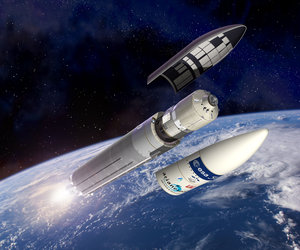Accept all cookies Accept only essential cookies See our Cookie Notice

About ESA
The European Space Agency (ESA) is Europe’s gateway to space. Its mission is to shape the development of Europe’s space capability and ensure that investment in space continues to deliver benefits to the citizens of Europe and the world.
Highlights
ESA - United space in Europe
This is ESA ESA facts Member States & Cooperating States Funding Director General Top management For Member State Delegations European vision European Space Policy ESA & EU Space Councils Responsibility & Sustainability Annual Report Calendar of meetings Corporate newsEstablishments & sites
ESA Headquarters ESA ESTEC ESA ESOC ESA ESRIN ESA EAC ESA ESAC Europe's Spaceport ESA ESEC ESA ECSAT Brussels Office Washington OfficeWorking with ESA
Business with ESA ESA Commercialisation Gateway Law at ESA Careers Cyber resilience at ESA IT at ESA Newsroom Partnerships Merchandising Licence Education Open Space Innovation Platform Integrity and Reporting Administrative Tribunal Health and SafetyMore about ESA
History ESA Historical Archives Exhibitions Publications Art & Culture ESA Merchandise Kids Diversity ESA Brand CentreLatest
Space in Member States
Find out more about space activities in our 23 Member States, and understand how ESA works together with their national agencies, institutions and organisations.
Science & Exploration
Exploring our Solar System and unlocking the secrets of the Universe
Go to topicAstronauts
Missions
Juice Euclid Webb Solar Orbiter BepiColombo Gaia ExoMars Cheops Exoplanet missions More missionsActivities
International Space Station Orion service module Gateway Concordia Caves & Pangaea BenefitsLatest
Space Safety
Protecting life and infrastructure on Earth and in orbit
Go to topicAsteroids
Asteroids and Planetary Defence Asteroid danger explained Flyeye telescope: asteroid detection Hera mission: asteroid deflection Near-Earth Object Coordination CentreSpace junk
About space debris Space debris by the numbers Space Environment Report In space refuelling, refurbishing and removingSafety from space
Clean Space ecodesign Zero Debris Technologies Space for Earth Supporting Sustainable DevelopmentLatest
Applications
Using space to benefit citizens and meet future challenges on Earth
Go to topicObserving the Earth
Observing the Earth Future EO Copernicus Meteorology Space for our climate Satellite missionsCommercialisation
ESA Commercialisation Gateway Open Space Innovation Platform Business Incubation ESA Space SolutionsLatest
Enabling & Support
Making space accessible and developing the technologies for the future
Go to topicBuilding missions
Space Engineering and Technology Test centre Laboratories Concurrent Design Facility Preparing for the future Shaping the Future Discovery and Preparation Advanced Concepts TeamSpace transportation
Space Transportation Ariane Vega Space Rider Future space transportation Boost! Europe's Spaceport Launches from Europe's Spaceport from 2012Latest

Artist's view of Ariane 5 with the different ATV
Thank you for liking
You have already liked this page, you can only like it once!
Artist's view of Ariane 5 with the different ATV.
From left to right:
- ATV-1, Jules Verne, on Ariane 5, launched on 9 March 2008;
- ATV-2, Johannes Kepler, on Ariane 5, launched on 16 February 2011;
- ATV-3, Albert Einstein, on Ariane 5, launched on 23 March 2012;
- ATV-4, Edoardo Amaldi, on Ariane 5, launched on 15 June 2013;
- ATV-5, Georges Lemaitre, on Ariane 5, launch set for summer 2014.
The International Space Station depends on regular deliveries of experiment equipment and spare parts, as well as food, air and water for its permanent crew.
Since its first voyage in April 2008, the Automated Transfer Vehicle (ATV) has been an indispensable supply ship to the Space Station.
Approximately every 17 months, ATV carries 6.6 tonnes of cargo to the Station 400 km above Earth. An onboard high-precision navigation system automatically guides ATV on a rendezvous trajectory towards the orbital outpost, where it docks with the Station's Russian service module Zvezda.
ATV then remains attached as a pressurised module and integral part of the Station for up to six months. After that it detaches and reenters Earth's atmosphere, where it breaks up and burns, together with up to 6.4 tonnes of waste from the Station.
-
CREDIT
ESA–D. Ducros, 2014 -
LICENCE
ESA Standard Licence

Artist's view of the liftoff of Ariane 5 with ATV-5

Artist's view and cut open view of Ariane 5 with the…

Artist’s view of ATV-5 reentry

Ariane 5 fairing separation















 Germany
Germany
 Austria
Austria
 Belgium
Belgium
 Denmark
Denmark
 Spain
Spain
 Estonia
Estonia
 Finland
Finland
 France
France
 Greece
Greece
 Hungary
Hungary
 Ireland
Ireland
 Italy
Italy
 Luxembourg
Luxembourg
 Norway
Norway
 The Netherlands
The Netherlands
 Poland
Poland
 Portugal
Portugal
 Czechia
Czechia
 Romania
Romania
 United Kingdom
United Kingdom
 Slovenia
Slovenia
 Sweden
Sweden
 Switzerland
Switzerland

























